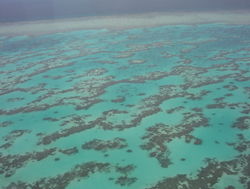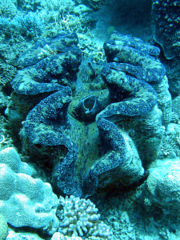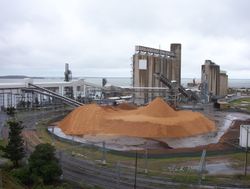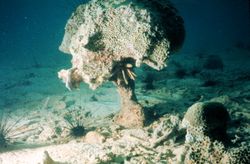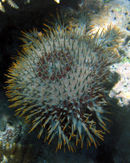Great Barrier Reef
2007 Schools Wikipedia Selection. Related subjects: Geography of Oceania (Australasia)
The Great Barrier Reef is the world's largest coral reef system, composed of roughly 3,000 individual reefs and 900 islands, that stretch for 2,600 kilometres (1,616 mi) covering an area of approximately 344,400 km2. The reef is located in the Coral Sea, off the coast of Queensland in northeast Australia. A large part of the reef is protected by the Great Barrier Reef Marine Park.
The Great Barrier Reef can be seen from outer space and is sometimes referred to as the single largest organism in the world. In reality, it is made up of many millions of tiny organisms, known as coral polyps. The Great Barrier Reef was also selected as a World Heritage Site in 1981. CNN has labelled it one of the seven natural wonders of the world. The Queensland National Trust has named it a state icon of Queensland.
Geology and Geography
Reefs fluctuate (grow and recede) as the sea level changes. The Cooperative Research Centre Reef Research Centre has found coral 'skeleton' deposits that date back half a million years.
According to the Great Barrier Reef Marine Park Authority, the current, living reef structure is believed to have begun growing on an older platform about 18,000 years ago. The Australian Institute of Marine Science places this event at 20,000 years ago - both of these estimates place the event at the time of the Last Glacial Maximum. At around that time, the sea level was 120 metres lower than it is today. The land that formed the substrate of the Great Barrier Reef was a coastal plain with some larger hills (some of which were themselves remnants of older reefs).
From 20,000 years ago until 6,000 years ago, the sea level rose steadily. As the sea level rose, the corals could grow higher on the hills of the coastal plain. By around 13,000 years ago the sea level was 60 metres less than the present day, and corals began to grow around the hills of the coastal plain - by then, continental islands. As the sea level rose further still, most of the contiental islands were submerged. The corals could then overgrow the hills, to form the present cays and reefs. Sea level on the Great Barrier Reef has not risen significantly in the last 6,000 years. The research outcomes funded by the CRC Reef Research Centre estimates the age of the present, living reef structure at 6,000 to 8,000 years old.
In the northern part of the Great Barrier Reef, ribbon reefs and deltaic reefs have formed - these reef structures are not found in the rest of the Great Barrier Reef system. The oldest dated coral on the reef now is a species of Porites known as boulder coral, which is only about 1,000 years old (it grows about 1 centimetre per year).
The remains of an ancient barrier reef similar to the Great Barrier Reef can be found in The Kimberley, a northern region of Western Australia.
Species of the Great Barrier Reef
The Great Barrier Reef supports a diversity of life, including many vulnerable or endangered species. 30 species of whales, dolphins, or porpoises have been recorded in the Great Barrier Reef, including the Dwarf Minke Whale, Indo-Pacific Humpback Dolphin and the Humpback Whale. Also, large populations of dugongs live there. Six species of sea turtle come to the reef to breed – Green Sea Turtle, Leatherback Sea Turtle, Hawksbill turtle, Loggerhead Sea Turtle, Flatback Turtle, and Olive Ridley. Over 200 species of birds (including 40 species of waterbirds) live on the Great Barrier Reef, including the White-bellied Sea Eagle and Roseate Tern. 5000 species of mollusc have been recorded on the Great Barrier Reef including the Giant Clam and various nudibranches and cone snails. 17 species of sea snake live on the Great Barrier Reef. More than 1500 species of fish live on the reef, including the Clownfish, Red Bass, Red-Throat Emperor, and several species of Snapper and Coral Trout. 400 species of corals, both hard corals and soft corals are found on the reef. There are 15 species of seagrass near the reef that attract the dugongs and sea turtles. 500 species of marine algae or seaweed live on the reef. The irukandji jellyfish also lives on the reef.
Environmental threats
Water quality
The coastline of north eastern Australia has no major rivers, (except during tropical flood events caused by tropical cyclones). It also has several major urban centres including Cairns, Townsville, Mackay, Rockhampton and the industrial city of Gladstone.
Cairns and Townsville are the largest of these coastal cities with populations of approximately 150,000 each. Unlike most reef environments worldwide, the Great Barrier Reef is the only one where the water catchment area is home to industrialised urban areas and where extensive areas of coastal lands and rangelands have been used for agricultural and pastoral purposes.
Due to the range of human uses made of the water catchment area adjacent to the Great Barrier Reef some 400 of the 3000 reefs are within a risk zone where water quality has declined owing to sediment and chemical runoff from farming, and to loss of coastal wetlands which are a natural filter. Principal agricultural activity is sugar cane farming in the wet tropics and cattle grazing in the dry tropics regions. Both are considered significant factors affecting water quality.
It is thought that the mechanism behind poor water quality affecting the reefs is due to increased light and oxygen competition from algae, but it has also been suggested that poor water quality encourages the spread of infectious diseases among corals. The long-term monitoring program has found an increase in incidences of coral disease in the period 1999-2002, although they dispute the claim that on the Great Barrier Reef, coral diseases are caused by anthropogenic pollution.
Copper, a common industrial pollutant found in the waters of the Great Barrier Reef, has been shown to interfere with the development of coral polyps.
Climate change
Some people believe that the most significant threat to the status of the Great Barrier Reef and of the planet's other tropical reef ecosystems is climate change - comprising of global warming and the El Niño effect. Many of the corals of the Great Barrier Reef are currently living at the upper edge of their temperature tolerance, as demonstrated in the coral bleaching events of the summers of 1998, 2002 and most recently 2006.
As demonstrated in 1998, 2002 and 2006, corals expel their photosynthesising zooxanthellae and turn colourless, revealing their white calcium carbonate skeletons, under the stress of waters that remain too warm for too long. If the water does not cool within about a month, the coral will die. Australia experienced its warmest year on record in 2005. Abnormally high sea temperatures during the summer of 2005-2006 have caused massive coral bleaching in the Keppel Island group.
Global warming may have triggered the collapse of reef ecosystems throughout the tropics. Increased global temperatures are thought by some to bring more violent tropical storms, but reef systems are naturally resilient and recover from storm battering. While some believe that an upward trend in temperature will cause much more coral bleaching, others suggest that while reefs may die in certain areas, other areas will become habitable for corals, and form coral reefs.
However, the trend towards ocean acidification suggests that as the sea's pH decreases, corals will become less able to secrete calcium carbonate.
Reef scientist Terry Done has predicted a 1 degree rise in global temperature would result in 82 percent of the reef bleached, 2 degrees resulting in 97 percent and 3 degrees resulting in 'total devastation'.
Crown-of-thorns starfish
The crown-of-thorns starfish is a coral reef predator that preys on coral polyps by climbing onto them, extruding the stomach over them, and releasing digestive enzymes to then absorb the liquified tissue. An individual adult of this species can wipe out up to 6 square metres of living reef in a single year.
Although large outbreaks of these starfish are believed to occur in natural cycles, human activity in and around the Great Barrier Reef can worsen the effects. Reduction of water quality associated with agriculture can cause the crown-of-thorns starfish larvae to thrive. Overfishing of its natural predators, such as the Giant Triton, is also considered to contribute to an increase in the number of crown-of-thorns starfish. The CRC Reef Research Centre defines an outbreak of crown-of-thorns starfish to be when there are more than 30 adult starfish in an area of one hectare.
Overfishing
The unsustainable overfishing of keystone species, such as the Giant Triton, can cause disruption to food chains vital to life on the reef. Fishing also impacts the reef through increased pollution from boats, by-catch of unwanted species (such as dolphins and turtles) and reef habitat destruction from trawling, anchors and nets. As of the middle of 2004, approximately one-third of the Great Barrier Reef Marine Park is protected from species removal of any kind, including fishing, without written permission.
Shipping
Shipping accidents are also a real concern, as several commercial shipping routes pass through the Great Barrier Reef. From 1985-2001, there were 11 collisions and 20 groundings on the inner Great Barrier Reef shipping route. The leading cause of shipping accidents in the Great Barrier Reef is human error.
Although the route through the Reef is not easy, reef pilots consider it safer than outside the Reef in the event of mechanical failure since a ship can sit safely while being repaired. On the outside, wind and swell will push a ship towards the reef and the water is deep right up to the Reef so anchoring is impossible. Captain Cook in the Endeavour nearly came to grief that way, being utterly becalmed and pushed towards the reef by the swell. Right up to within 80 metres of the Reef, the water was so deep that no ground (to anchor against) could be felt with 220 metres of line.
Waste and foreign species discharged in ballast water from ships (when purging procedures are not followed) are a biological hazard to the reef. Tributyltin (TBT) compounds found in some antifouling paint on ship hulls leaches into seawater and is toxic to marine organisms and humans; efforts are underway to restrict its use.
Oil
It is suspected that the Great Barrier Reef is the cap to an oil trap. In the 1960s and early 1970s, there was some speculation about drilling for oil and gas there. In 1970, two Royal Commissions were ordered "into exploratory and production drilling for petroleum in the area of the Great Barrier Reef". Oil drilling is not permitted on the Great Barrier Reef, yet oil spills are still considered "one of the biggest threats to the reef", with a total of 282 oil spills between 1987-2002.
Human use of the Great Barrier Reef
The Great Barrier Reef has long been known to and utilised by Indigenous Australian people, whose occupation of the continent is thought to extend back 40,000 to 60,000 years or more. For these 70 or so clan groups, the reef is also an important part of their Dreamtime.
The Reef first became known to Europeans when the HM Bark Endeavour, captained by explorer James Cook, ran aground there on June 11, 1770 and sustained considerable damage. It was finally saved after lightening the ship as much as possible and re-floating it during an incoming tide. One of the most famous wrecks was that of the HMS Pandora, which sank on August 29, 1791 killing 35. The Queensland Museum has been leading archaeological digs to the Pandora since 1983.
Management
After the Royal Commissions' findings, in 1975, the Government of Australia created the Great Barrier Reef Marine Park and defined what activities were prohibited on the Great Barrier Reef. The park is managed, in partnership with the Government of Queensland, through the Great Barrier Reef Marine Park Authority to ensure that it is widely understood and used in a sustainable manner. A combination of zoning, management plans, permits, education and incentives (such as eco-tourism certification) are used in the effort to conserve the Great Barrier Reef.
In July 2004, a new zoning plan was brought into effect for the entire Marine Park, and has been widely acclaimed as a new global benchmark for the conservation of marine ecosystems. While protection across the Marine Park was improved, the highly protected zones increased from 4.5% to over 33.3%. At the time, it was the largest marine protected area in the world, although as of 2006, the Northwestern Hawaiian Islands National Monument is the largest.
In 2006, a review was undertaken of the Great Barrier Reef Marine Park Act 1975. Some recomendations of the review are that there should be no further zoning plan changes until 2013, and that every five years, a peer-reviewed Outlook Report should be published, examining the health of the Great Barrier Reef, the management of the Reef, and environmental pressures.
Tourism
Due to its vast biodiversity, warm clear waters and its accessibility from the floating guest facilities called ' live aboards', the reef is a very popular destination for tourists, especially scuba divers. Many cities along the Queensland coast offer boat trips to the reef on a daily basis. Several continental islands have been turned into resorts.
As the largest commercial activity in the region, it has been estimated in 2003 that tourism in the Great Barrier Reef generates over AU$4 billion annually. (A 2005 estimate puts the figure at AU$5.1 billion.) There are approximately two million visitors to the Great Barrier Reef each year. Although most of these visits are managed in partnership with the marine tourism industry, there are some very popular areas near shore (such as Green Island) that have suffered damage due to overfishing and land based run off.
A variety of boat tours and cruises are offered, from single day trips, to longer voyages. Boat sizes range from dinghies to superyachts. Glass-bottomed boats and underwater observatories are also popular, as are helicopter flights. But by far, the most popular tourist activities on the Great Barrier Reef are snorkelling and diving. Pontoons are often used for snorkelling and diving. When a pontoon is used, the area is often enclosed by nets. The outer part of the Great Barrier Reef is favoured for such activities, due to water quality.
Management of tourism in the Great Barrier Reef is geared towards making tourism ecologically sustainable. A daily fee is levied that goes towards research of the Great Barrier Reef. This fee ends up being 20% of the GBRMPA's income.Plans of management are also in place for the popular tourist destinations of Cairns and the Whitsunday Islands, which comprise 85% of tourism in the region. Policies on cruise ships, bareboat charters, and anchorages limit the traffic on the Great Barrier Reef. The 2003 Pixar film, Finding Nemo, featured the Great Barrier Reef as a setting.
Fishing
The fishing industry in the Great Barrier Reef, controlled by the Queensland Government, is worth AU$1 billion annually. It employs approximately 2000 people, and fishing in the Great Barrier Reef is pursued commercially, for recreation, and as a traditional means for feeding one's family. Wonky holes in the reef provide particularly productive fishing areas.

